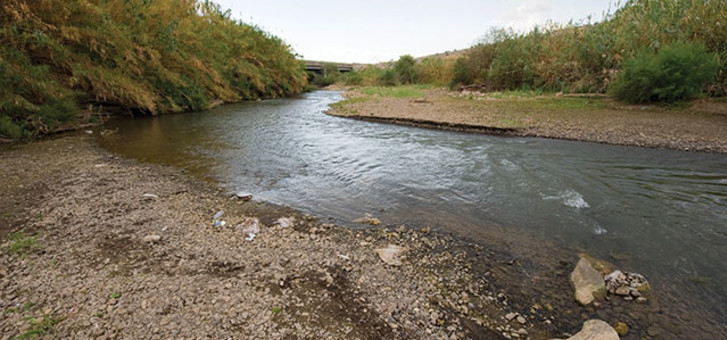Have you ever been short-changed? It may have been unintentional, but as you looked at the wrong change the cashier gave you, you were probably quick to point out the mistake. The irony is that many of us have been short-changed in our religious lives and yet have failed to do anything about it.
Our story begins at the time when Jesus was ready to commence His ministry as a Rabbi. He had left His hometown of Nazareth and walked to the Jordan River, some 250 kilometres away. Here, John the Baptist, the greatest prophet of his time, was calling for repentance and baptism as the “kingdom of heaven has come near” (Matthew 3:3).
John had chosen to preach and baptise at a place called Aenon, near Salim in the Jordan Valley (John 3:23). Today, no known site bears the name of Aenon or Salim, but ancient church historian Jerome places it about 12 kilometres south of Beit She’an, today a city in the North District of Israel, located at the junction of the Jordan River valley and the Jezreel Valley. This is confirmed on the Madaba Map, found in the early Byzantine church of Saint George at Madaba, Jordan. Dating to the sixth century AD, it is the oldest surviving original cartographic depiction of the Holy Land.
The reason John chose Aenon was because he needed a place with plenty of water in order to baptise people, since the custom was to fully immerse the candidate under the water. The Bible confirms this with its description of Jesus’ baptism: “As soon as Jesus was baptised, he went up out of the water” (Matthew 3:16; italics added).
Always performed by total immersion in water, the Jews have traditionally practised baptism for anybody wishing to join Judaism. It was also practised as a rite of purification by the other religions of the time. And so John adapted this and used it for adults who wanted to show their acceptance of his teachings and that they had forsaken a lifestyle inconsistent with the kingdom of heaven.
When Jesus was baptised by John that day, He was actually without sin. With nothing to renounce or leave behind to start a new life, He had no real need to be baptised. John recognised that when he protested, saying, “I need to be baptised by you, and do you come to me?” (Matthew 3:14).
But Jesus, who came to be humanity’s Redeemer, is also our Example, and so He asked John to proceed, to show the way for us. The apostle Paul tells us the real meaning behind the practice of baptism today. He says, “Don’t you know that all of us who were baptised into Christ Jesus were baptised into his death? We were therefore buried with him through baptism into death in order that, just as Christ was raised from the dead through the glory of the Father, we too may live a new life” (Romans 6:3, 4).
When we bury a dead body, we would not consider just sprinkling a few grains of soil onto the coffin—it is a complete covering. According to Paul, baptism represents a burial of the old self, which is filled with sinful habits—by immersing ourselves completely in water. Then, by re-emerging from the water, we represent a resurrection to a new life, renouncing our sinful ways, declaring our wish to live only for Jesus. The act of our baptism is a representation of the death, burial and resurrection of Jesus Himself.
Some of Jesus’ last words on earth were, “Go and make disciples of all nations, baptising them in the name of the Father and of the Son and of the Holy Spirit, and teaching them to obey everything I have command-
ed you” (Matthew 28:19, 20). Because the command included the name of the Father, the Son and the Holy Spirit, many Christians have been baptised by being immersed under the water thrice—once in each Name of the Members of the Trinity. Many Christians today, however, practise just one immersion, in the Names of the three Persons of God.
The early Christian church practised this rite of baptism by immersion right across the world. Their earliest artwork shows Jesus in water at His baptism. Baptisteries for adults were built worldwide. The ruins of an early Christian church at Cuma, near Naples, dates back to the fourth or fifth century AD. In these ruins is a rather prominent feature, a circular baptismal font situated right where the altar would normally be located. Then there is the huge octagonal baptistery of St John Lateran, for centuries the main church of Rome, which has become a model for many other baptisteries throughout Europe.
As time progressed and when the weather was extremely cold, the procedure of just sprinkling or pouring a little water on the head began to be used.
It was symbolic as “holy water” was often used, and of course it was not as inconvenient for candidates as a full water immersion. It’s a practice that has become commonly used today, particularly as infant baptism began to become the norm, which leads to another problem.
Jesus said to His disciples, “Go into all the world and preach the gospel to all creation. Whoever believes and is baptised will be saved, but whoever does not believe will be condemned” (Mark 16:15, 16; italics added).
The Bible says baptism is for those who wish to demonstrate their faith, forsake sin and follow Jesus. So they need to show their knowledge of the sacrifice, the death and burial of Jesus, and His resurrection. It is only because of their faith and belief in Him that they should follow His example into the waters of baptism. This of course means that infant baptism does not meet the full requirements of a new life with Jesus.
So why would we want to be short-changed in such a meaningful event in a person’s life? When sprinkling and pouring of water has no symbolic meaning from baptism and the example of Jesus, why be willing to settle for less than what Jesus gave us with His example? The rich symbolism in a baptism involving a full immersion in water makes the decision to follow our Lord so much more meaningful and links us to Him who gave the commission to believe and be baptised.
The Anabaptists
Baptism by immersion was rediscovered by people around Zurich, Switzerland, following study of Scripture and the great belief that we are made right with God by faith in Christ and His death, rediscovered by Martin Luther and taken up by Ulrich Zwingli. Some there continued their search of Scripture, finding that such a form of baptism is sanctioned by Jesus Himself, and that the mode of baptism is vitally important. These people who insisted on a “believer’s baptism” became known as the Anabaptists, meaning “re-baptisers.” The Anabaptists saw the words of Jesus in Mark 16:15, 16 as a definite requirement that candidates for baptism needed to believe in the good news. At a time where infant baptism was widely practised and promoted, many died for their faith—often after torture. They were persecuted by Catholics and Protestants, Luther and Zwingli alike.




